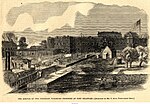Fort Delaware State Park

Fort Delaware State Park is a 288-acre (117 ha) Delaware state park on Pea Patch Island in New Castle County, Delaware. A fortress was built on Pea Patch Island by the United States Army in 1815, near the conclusion of the War of 1812, to protect the harbors of Wilmington, Delaware and Philadelphia, Pennsylvania. The fort was burned and rebuilt in the years prior to the American Civil War, and soon after the start of the war the fort was converted to a Prisoner of War camp. Fort Delaware continued to protect the mouth of the Delaware River through World War I and II. Pea Patch Island and Fort Delaware was declared surplus land by the United States Department of Defense in 1945. Fort Delaware State Park, one of the first state parks in Delaware, was established in 1951. The park, which can only be accessed by ferry, is open for historic programs at Fort Delaware. The fort is listed on the National Register of Historic Places. In addition to historical preservation, Fort Delaware State Park is also open for picnicking and hiking. Visitors to the park may reach it by ferry from Delaware City or Fort Mott State Park in New Jersey. Fort Delaware State Park is 0.5-mile (800 m) from Delaware City via the Forts Ferry Crossing. Passengers aboard the ferry are granted access to Fort Mott State Park.
Excerpt from the Wikipedia article Fort Delaware State Park (License: CC BY-SA 3.0, Authors, Images).Fort Delaware State Park
Clinton Street,
Geographical coordinates (GPS) Address Nearby Places Show on map
Geographical coordinates (GPS)
| Latitude | Longitude |
|---|---|
| N 39.593055555556 ° | E -75.572222222222 ° |
Address
Fort Delaware
Clinton Street
19706
Delaware, United States
Open on Google Maps









